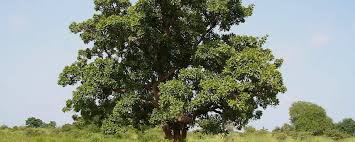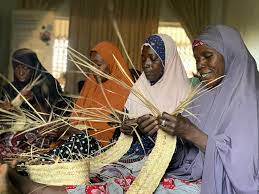
Nigeria, often referred to as the "Giant of Africa," is blessed with an abundance of natural resources. Among them is the shea tree (Vitellaria paradoxa), which produces the highly sought-after shea nut. With its increasing global demand, shea nut production has emerged as a vital sector within Nigeria's agricultural industry.
Nigeria has about five million (5,000,000) hectares of Shea trees, but all are in the wild. The country produces about six hundred thousand (600,000) tons per annum.
This article explores the journey of shea nut production in Nigeria, highlighting its economic significance, cultivation practices, processing methods, challenges, and potential for sustainable development.
Shea nut production plays a crucial role in Nigeria's economy, both at the national and community levels.
Nigeria is one of the largest shea nut producers globally, accounting for a significant share of the global market. The export of shea nuts and shea butter provides a substantial source of revenue for the country, contributing to foreign exchange earnings and employment opportunities.
Climatic Requirements
Temperature: Shea nut trees thrive in tropical and subtropical regions, where temperatures typically range from 25 to 35 degrees Celsius. The optimal temperature range for Shea nut cultivation is between 25 and 30 degrees Celsius. Temperatures below 18 degrees Celsius can adversely affect the growth and development of the tree, while frost conditions are detrimental.
Rainfall: Shea nut trees are drought-tolerant, but they require a well-distributed rainfall pattern for optimal growth. In Nigeria, the recommended annual rainfall range for Shea nut cultivation is between 600 and 1,200 millimeters. Excessive rainfall or waterlogging can negatively impact the trees, emphasizing the importance of well-drained soils.
Humidity: Shea nut trees prefer moderate to high humidity levels, which are commonly found in the tropical regions of Nigeria. High humidity promotes the healthy growth of the tree and helps in the production of quality nuts. However, prolonged periods of high humidity, coupled with poor air circulation, can increase the susceptibility of the trees to diseases and pests.
Sunshine: Shea nut trees require abundant sunshine for optimal growth and nut production. They thrive in areas with an average of 1,800 to 2,500 hours of sunshine per year. Adequate sunlight ensures proper photosynthesis and the development of healthy foliage, leading to higher yields.
Soil Requirements
Soil Type: Shea nut trees can adapt to various soil types, but they perform best in well-drained, deep, and fertile soils. Sandy loam and loamy soils are ideal for Shea nut cultivation. These soils allow for proper root development and good water drainage while retaining sufficient moisture for the tree's needs.
Soil pH: The optimal soil pH range for Shea nut cultivation is between 6.0 and 7.5. Soils within this range provide a suitable environment for nutrient uptake by the tree's roots. Conducting a soil test before planting is recommended to ensure proper soil pH and nutrient levels.
Soil Texture: Shea nut trees prefer soils with a medium to fine texture. Sandy soils are well-drained but may require additional organic matter to improve water retention. Clay soils, on the other hand, can be problematic as they tend to retain excess moisture, leading to waterlogged conditions and root rot. Mixing organic matter such as compost or well-rotted manure into the soil can enhance its texture and fertility.
Soil Fertility: Shea nut trees benefit from fertile soils with good organic matter content. Organic matter improves soil structure, enhances moisture retention, and promotes nutrient availability. Incorporating organic amendments into the soil before planting, such as compost or well-rotted manure, can provide a nutrient-rich environment for the trees.
Drainage: Adequate soil drainage is crucial for Shea nut cultivation. Poorly drained soils can lead to waterlogging, which can cause root rot and adversely affect tree growth. If the soil has drainage issues, implementing measures such as contour plowing, raised beds, or installing drainage channels can help alleviate the problem.
Varieties of Shea Nut Cultivation
Traditional Varieties: Traditional varieties of shea nut cultivation have been cultivated for generations in Nigeria. These varieties are adapted to local agroecological conditions and are well-known for their resilience and oil content. Some popular traditional varieties include:
Bambuki: This variety is commonly found in the northern parts of Nigeria, particularly in Kano and Katsina states. Bambuki shea nuts are characterized by their high oil content and excellent quality.
Gaya: Gaya shea nuts are cultivated in the Kano and Jigawa states. They are renowned for their large size and robust oil content, making them highly sought after.
Borno: Borno shea nuts are predominantly grown in the Borno state of Nigeria. They are known for their high oil content and resistance to pest and disease infestations.
Improved Varieties: In recent years, efforts have been made to develop improved varieties of shea nut cultivation in Nigeria. These varieties are bred to enhance productivity, oil yield, and disease resistance. Some noteworthy improved varieties include:
Okumani: Developed by the International Institute of Tropical Agriculture (IITA), Okumani is a high-yielding variety known for its large nut size and excellent oil content. It is widely cultivated in various regions of Nigeria.
Kpalaga: Kpalaga shea nuts are a product of the collaborative efforts between IITA and the Nigerian Agricultural Research Institutes. This variety exhibits high resistance to drought and pests, making it suitable for cultivation in arid regions.
Abofu: Abofu shea nuts are a result of extensive research conducted by the Federal University of Agriculture, Abeokuta. This variety is known for its high oil content and rapid growth, making it an attractive option for commercial cultivation.
Cultivation Practices
The shea tree is indigenous to West Africa, including Nigeria, and thrives in the savanna regions of the country. Shea nut cultivation typically involves a combination of wild collection and plantation farming. Local farmers are the primary cultivators, with their expertise passed down through generations.
The process begins by selecting healthy shea tree seeds, which are planted in well-prepared soil during the rainy season. The young trees require careful nurturing, including protection from pests and diseases, until they mature and start bearing fruit.
Pest and Diseases
Shea nut (Vitellaria paradoxa) is an important crop in Nigeria, known for its valuable nuts and butter. However, like any agricultural crop, shea nut cultivation is not immune to the challenges posed by pests and diseases.
Pests Affecting Shea Nut Cultivation
Shea Seed Pod Borers (Mylabris spp. and Apate spp.): These pests cause significant damage by boring into the shea nut pods. The larvae feed on the developing seeds, leading to reduced yields and poor-quality nuts.
The presence of exit holes on the pods is a clear indication of their infestation. To control seed pod borers, regular monitoring, manual removal of infested pods, and proper sanitation are essential. Chemical control methods can be used as a last resort.
Shea Leaf Roller (Etiella zinckenella): The shea leaf roller is a notorious pest that damages the leaves and young shoots of shea trees. Infested leaves exhibit rolling or folding symptoms, leading to reduced photosynthesis and stunted growth. Manual removal of infested leaves and the use of botanical insecticides can be effective in managing these pests.
Shea Stem Borer (Coelaenomenodera elaeidis): Shea stem borers attack the main trunk and branches of shea trees, causing extensive damage. They create galleries within the stem, leading to weakened trees and even death in severe cases.
Preventive measures such as proper pruning, removing and destroying infested branches, and maintaining tree vigor through good cultural practices can help control stem borers.
Diseases Affecting Shea Nut Cultivation
Shea Witches' Broom (Phyllanthus spp.): Shea witches' broom is a devastating disease caused by phytoplasma. It manifests as excessive shoot proliferation, resulting in a broom-like appearance. Infected trees produce fewer and smaller nuts, leading to reduced yields.
The disease is primarily transmitted through insect vectors. To manage shea witches' broom, prompt removal and destruction of infected plant parts, avoiding intercropping with susceptible hosts, and controlling the insect vectors are important.
Shea Anthracnose (Colletotrichum gloeosporioides): Anthracnose is a fungal disease that affects shea nuts, causing dark sunken lesions on the shells. Infected nuts are prone to mold growth, reducing their quality and market value. Good orchard sanitation, removal and destruction of infected nuts, and application of appropriate fungicides can help control shea anthracnose.
hea Powdery Mildew (Oidium spp.): Powdery mildew is a fungal disease that affects shea leaves, stems, and fruits. It appears as a white powdery growth on the plant surfaces, leading to leaf distortion and reduced photosynthesis. Maintaining good air circulation, practicing proper pruning, and applying fungicides can aid in managing shea powdery mildew.
Integrated Pest and Disease Management (IPDM) Strategies
To effectively manage pests and diseases in shea nut cultivation, an integrated approach is crucial. The following IPDM strategies can help mitigate the risks:
Cultural Practices: Implement good agricultural practices such as proper sanitation, regular pruning, and removal of infected plant parts. Maintaining tree vigor through balanced nutrition and irrigation also enhances the plant's resilience against pests and diseases.
Biological Control: Encourage natural enemies such as predators, parasitoids, and beneficial microorganisms to control pest populations. Implementing biological control programs can provide sustainable and environmentally friendly pest management solutions.
Chemical Control: When necessary, judicious use of chemical pesticides can be employed. However, it is essential to follow label instructions, apply appropriate dosages, and consider the potential impacts on the environment and non-target organisms.
Monitoring and Early Detection: Regular monitoring of shea nut orchards for pest and disease symptoms is crucial. Early detection allows for timely intervention, preventing the escalation of infestations and minimizing damage.
Harvesting and Processing
Shea nuts are harvested once the shea tree reaches maturity, usually after fifteen to twenty (15 to 20) years. The harvesting season varies depending on the region and climatic conditions, but it generally occurs during the dry season when the nuts have fully ripened. The harvesting season typically occurs between June and August.
Traditionally, the nuts are collected by hand from the ground after they fall naturally from the trees. However, more efficient methods, such as shaking the tree branches or using long poles to dislodge the nuts, are also employed.
Processing shea nuts involves several stages. First, the nuts are sorted and washed to remove any impurities. Then, they are sun-dried to reduce moisture content. Subsequently, the dried nuts are roasted, cracked, and winnowed to separate the shells from the kernels.
The kernels, or shea nuts, are then crushed and ground into a paste, which is commonly known as shea butter. This creamy substance holds immense value due to its various applications in the cosmetic, pharmaceutical, and food industries.
Challenges and Opportunities
Despite its economic potential, shea nut production in Nigeria faces several challenges. Insufficient access to credit and financial resources limits the expansion of shea farming and processing activities. Lack of modern processing facilities and equipment hampers productivity and quality standards. Additionally, inadequate infrastructure, including transportation networks, poses hurdles in reaching international markets in a timely manner.
However, these challenges also present opportunities for development. Increased investments in the shea nut sector, both from public and private entities, can improve infrastructure, provide training and capacity building to farmers, and enhance processing capabilities.
Collaborations with international organizations and the adoption of sustainable farming practices can further enhance the quality and competitiveness of Nigerian shea nut products in the global market.
Sustainable Development and Social Impact
Shea nut production in Nigeria has a significant social impact, particularly on rural communities. The sector provides employment opportunities for women, who are often involved in the collection, processing, and marketing of shea nuts and shea butter. Shea nut production is known to empower women economically, improving their livelihoods and promoting gender equality.
Furthermore, sustainable shea nut production contributes to environmental conservation. Shea trees are valuable for their ability to prevent soil erosion, enhance biodiversity, and act as a carbon sink. Promoting sustainable farming practices, such as agroforestry systems and reforestation efforts, can help protect the shea tree ecosystem and support climate change mitigation.
Conclusion
Shea nut production in Nigeria has evolved from a traditional practice to a significant contributor to the country's economy. With its abundant natural resources, Nigeria has the potential to strengthen its position as a global leader in the shea nut industry.
By addressing the challenges faced by the sector and focusing on sustainable development, Nigeria can harness the economic and social benefits of shea nut production while promoting environmental stewardship.






















